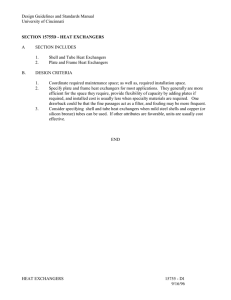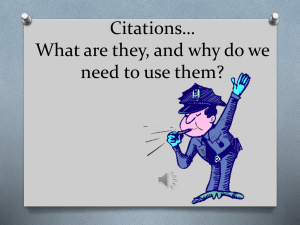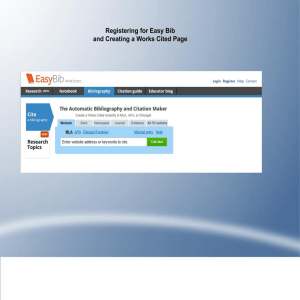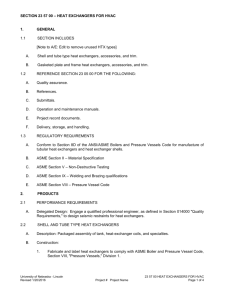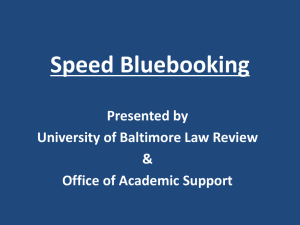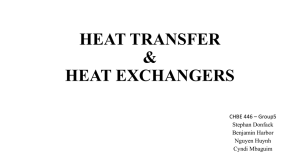Citing Sources
advertisement
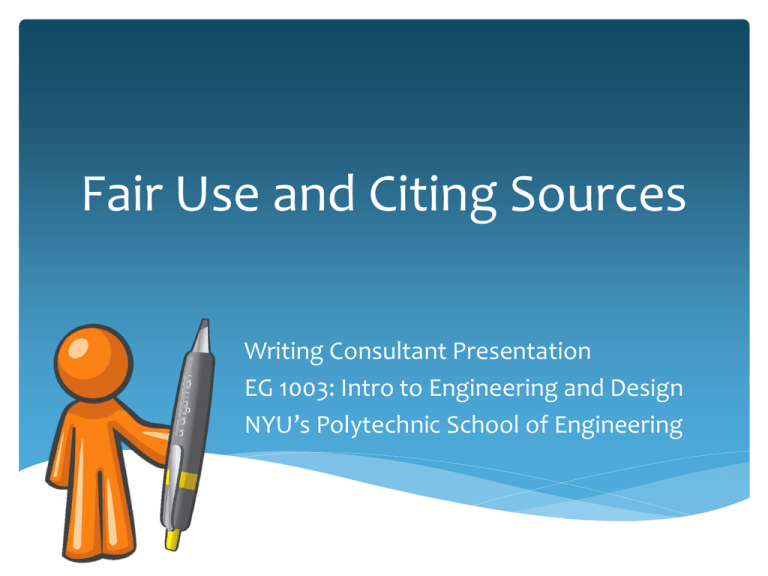
Fair Use and Citing Sources Writing Consultant Presentation EG 1003: Intro to Engineering and Design NYU’s Polytechnic School of Engineering Fair Use and Citing Sources What is fair use? Citation style that respects fair use Resources for more information Creators get automatic rights Profit from their words or images Permit others to reproduce their work Create “derivative works” (summaries, movies, translations, etc.) Perform or display in public Rationale for “fair use” Without quoting (making a derivative) … research and public conversation cease Criticism, review, commentary, parody, news reports are important to free society Some copyright infringements are worthwhile What is “fair use”? Court defense against infringement No strict definition exists: “There is no specific number of words, lines, or notes that may safely be taken without permission. Acknowledging the source of the copyrighted material does not substitute for obtaining permission”1 Not itself a right 1 U.S. Copyright Office, “Fair Use,” retrieved 20 January 2011 from copyright.gov. Conditions for fair use defense 1. In the context of commentary, scholarly report, review, or parody 2. Only a small portion of entire text or picture 3. Cannot harm the market for the work 4. Must indicate source Fair Use and Citing Sources What is fair use? Citation style that respects fair use Resources for more information Issues related to EG 1003 Indicate when you use an idea outside your own experience with quote marks or citation Take only brief passages and cite the source so reader can verify original Use only a portion of pictures in context of commentary or review Exploit free clipart or create your own Author-date citation system Basis of many systems, including IEEE and APA Simple to implement: • Author’s last name and year in text • Full bibliographic information at end Use for all outside sources: • • • • • EG 1003 Lab Manual Web pages News reports Dictionaries Textbooks Using a lead-in phrase Original Text A large number of production facilities in many industries use processes in which heat is transferred between different fluids. The basic principle of heat transfer is extremely simple[;] two fluids at different temperatures are placed in contact with a conductive barrier (the tube wall) and heat is transferred from the hotter fluid to the colder fluid until they reach the same temperature level. In industrial processes this is carried out in heat exchangers of various types and styles usually purpose built for the process and site conditions of the application. HRS Heat Exchangers. 2014. “Heat Transfer Fundamentals.” hrs-heatexchangers.com. Quote According to HRS Heat Exchangers (2014), a “large number” of industrial processes use heat transfer. Heat exchangers are “purpose built for the process and site conditions of the application.” Paraphrase According to HRS Heat Exchangers (2014), many industries use simple heat transfer processes where a barrier between fluids conducts heat until equilibrium is reached. Using a parenthetical citation Original Text A large number of production facilities in many industries use processes in which heat is transferred between different fluids. The basic principle of heat transfer is extremely simple[;] two fluids at different temperatures are placed in contact with a conductive barrier (the tube wall) and heat is transferred from the hotter fluid to the colder fluid until they reach the same temperature level. In industrial processes this is carried out in heat exchangers of various types and styles usually purpose built for the process and site conditions of the application. HRS Heat Exchangers. 2014. “Heat Transfer Fundamentals.” hrs-heatexchangers.com. Quote A “large number” of industrial processes use heat transfer. Heat exchangers are “purpose built for the process and site conditions of the application” (HRS Heat Exchangers 2014). Paraphrase Many industries use simple heat transfer processes where a barrier between fluids conducts heat until equilibrium is reached (HRS Heat Exchangers 2014). Works cited section for end of report Works Cited Anderson, Nick. 26 January 2011. “U.S. Students Falling Short in Science.” Washington Post. Accessed 27 January 2011 from washingtonpost.com. HRS Heat Exchangers. 2014. “Heat Transfer Fundamentals,” Accessed 24 August 2014 from hrs-heatexchangers.com. Polytechnic Institute of NYU. 2014. “Lab 11: Heat Transfer and Thermal Insulation.” EG 1003 Online Lab Manual. Accessed 24 August 2014 from manual.eg.poly.edu. Welty, James R. 2008. Fundamentals of Momentum, Heat, and Mass Transfer. Hoboken, NJ: Wiley. Works cited section for end of report Alphabetic by last name Year of publication (date when possible) Anderson, Nick. 26 January 2011. “U.S. Students Falling Short in Science.” Washington Post. Accessed 27 January 2011 from washingtonpost.com. Web articles: access date but not full URL HRS Heat Exchangers. 2014. “Heat Transfer Fundamentals,” Accessed 24 August 2014 from hrs-heatexchangers.com. Polytechnic Institute of NYU. 2011. “Lab 11: Heat Transfer and Thermal Insulation.” EG 1003 Online Lab Manual. Accessed 24 August 2014 from manual.eg.poly.edu. Welty, James R. 2008. Fundamentals of Momentum, Heat, and Mass Transfer. Hoboken, NJ: Wiley. Portion of longer work; has corporate author Books include city and publisher Cite sources twice in reports ① In-text citation: Whenever outside ideas come into a report Use both with quotes and your own words ② Works Cited section: List of all sources Separate section at end of report Enough information to check the original Slides are a different animal Audience cannot turn to end of report Best practice is to have handout with sources Without handout, include both in-text citations and works cited info on the slide According to Nick Anderson, almost two-thirds of U.S. students cannot explain heat transfer1 1 Anderson, Nick. 26 January 2011. “U.S. Students Falling Short in Science.” Washington Post. Accessed 27 January 2011 from washingtonpost.com. Fair Use and Citing Sources What is fair use? Citation style that respects fair use Resources for more information More information on author-date Chicago Manual of Style Online “Citation Quick Guide” http://www.chicagomanualofstyle.org/tools_citationguide.html Purdue Online Writing Lab “Chicago Manual of Style 16th Edition” http://owl.english.purdue.edu/owl/resource/717/01/ NYU-Poly Writing Center (718) 260-3425 tutoring@poly.edu Other documentation systems Style name Disciplines Quick guide CSE Biology, chemistry, physics http://bcs.bedfordstmartins.com/resd oc5e/RES5e_ch11_s1-0002.html IEEE EE, CS http://www.ieee.org/documents/style manual.pdf APA Social Sciences http://www.apastyle.org Fair Use and Citing Sources What is fair use? Citation style that respects fair use Resources for more information
